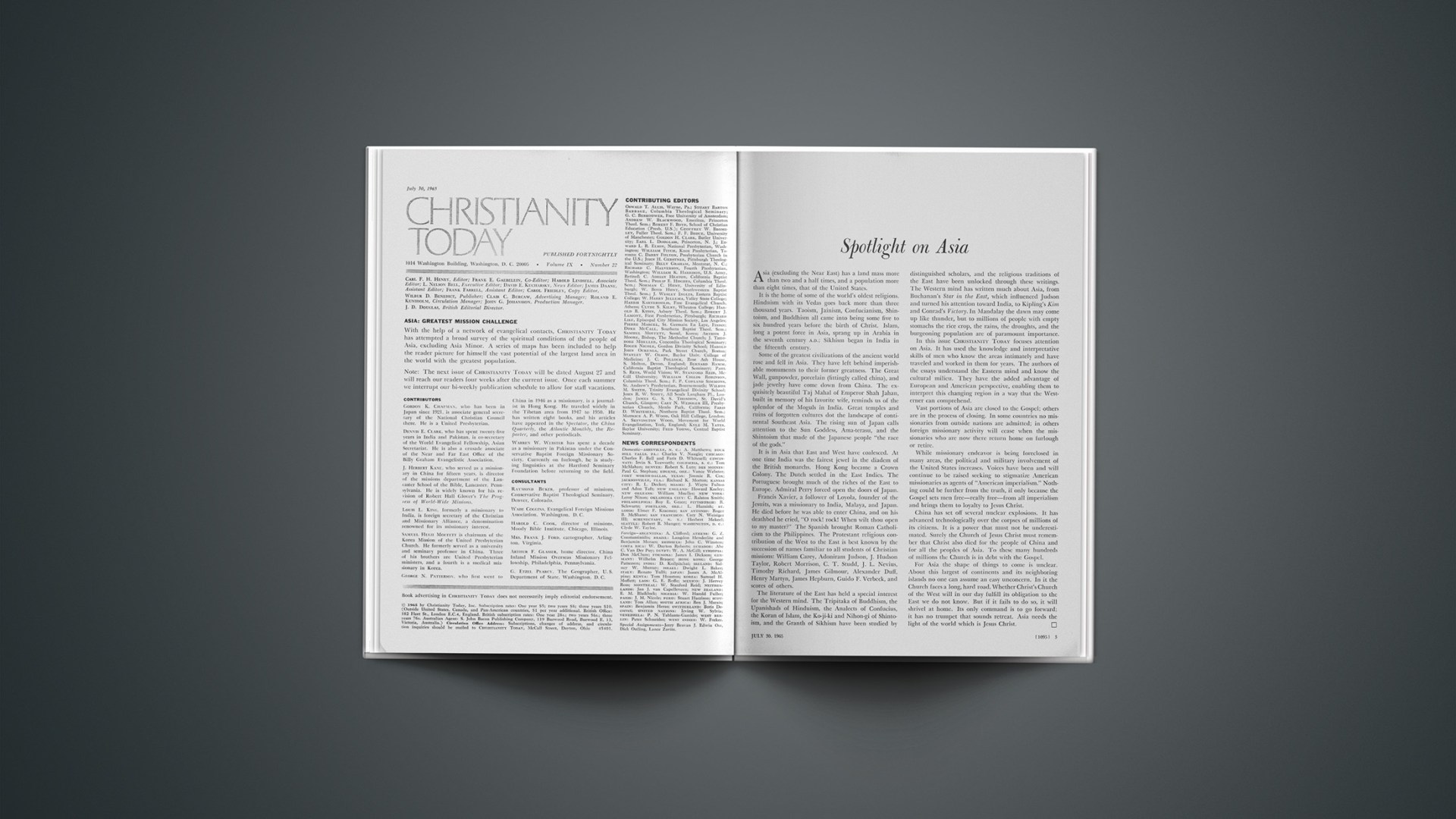Asia (excluding the Near East) has a land mass more than two and a half times, and a population more than eight times, that of the United States.
It is the home of some of the world’s oldest religions. Hinduism with its Vedas goes back more than three thousand years. Taoism, Jainism, Confucianism, Shintoism, and Buddhism all came into being some five to six hundred years before the birth of Christ. Islam, long a potent force in Asia, sprang up in Arabia in the seventh century A.D.; Sikhism began in India in the fifteenth century.
Some of the greatest civilizations of the ancient world rose and fell in Asia. They have left behind imperishable monuments to their former greatness. The Great Wall, gunpowder, porcelain (fittingly called china), and jade jewelry have come down from China. The exquisitely beautiful Taj Mahal of Emperor Shah Jahan, built in memory of his favorite wife, reminds us of the splendor of the Moguls in India. Great temples and ruins of forgotten cultures dot the landscape of continental Southeast Asia. The rising sun of Japan calls attention to the Sun Goddess, Ama-terasu, and the Shintoism that made of the Japanese people “the race of the gods.”
It is in Asia that East and West have coalesced. At one time India was the fairest jewel in the diadem of the British monarchs. Hong Kong became a Crown Colony. The Dutch settled in the East Indies. The Portuguese brought much of the riches of the East to Europe. Admiral Perry forced open the doors of Japan.
Francis Xavier, a follower of Loyola, founder of the Jesuits, was a missionary to India, Malaya, and Japan. He died before he was able to enter China, and on his deathbed he cried, “O rock! rock! When wilt thou open to my master?” The Spanish brought Roman Catholicism to the Philippines. The Protestant religious contribution of the West to the East is best known by the succession of names familiar to all students of Christian missions: William Carey, Adoniram Judson, J. Hudson Taylor, Robert Morrison, C. T. Studd, J. L. Nevius, Timothy Richard, James Gilmour, Alexander Duff, Henry Martyn, James Hepburn, Guido F. Verbeck, and scores of others.
The literature of the East has held a special interest for the Western mind. The Tripitaka of Buddhism, the Upanishads of Hinduism, the Analects of Confucius, the Koran of Islam, the Ko-ji-ki and Nihon-gi of Shintoism, and the Granth of Sikhism have been studied by distinguished scholars, and the religious traditions of the East have been unlocked through these writings. The Western mind has written much about Asia, from Buchanan’s Star in the East, which influenced Judson and turned his attention toward India, to Kipling’s Kim and Conrad’s Victory. In Mandalay the dawn may come up like thunder, but to millions of people with empty stomachs the rice crop, the rains, the droughts, and the burgeoning population are of paramount importance.
In this issue CHRISTIANITY TODAY focuses attention on Asia. It has used the knowledge and interpretative skills of men who know the areas intimately and have traveled and worked in them for years. The authors of the essays understand the Eastern mind and know the cultural milieu. They have the added advantage of European and American perspective, enabling them to interpret this changing region in a way that the Westerner can comprehend.
Vast portions of Asia are closed to the Gospel; others are in the process of closing. In some countries no missionaries from outside nations are admitted; in others foreign missionary activity will cease when the missionaries who are now there return home on furlough or retire.
While missionary endeavor is being foreclosed in many areas, the political and military involvement of the United States increases. Voices have been and will continue to be raised seeking to stigmatize American missionaries as agents of “American imperialism.” Nothing could be further from the truth, if only because the Gospel sets men free—really free—from all imperialism and brings them to loyalty to Jesus Christ.
China has set off several nuclear explosions. It has advanced technologically over the corpses of millions of its citizens. It is a power that must not be underestimated. Surely the Church of Jesus Christ must remember that Christ also died for the people of China and for all the peoples of Asia. To these many hundreds of millions the Church is in debt with the Gospel.
For Asia the shape of things to come is unclear. About this largest of continents and its neighboring islands no one can assume an easy unconcern. In it the Church faces a long, hard road. Whether Christ’s Church of the West will in our day fulfill its obligation to the East we do not know. But if it fails to do so, it will shrivel at home. Its only command is to go forward; it has no trumpet that sounds retreat. Asia needs the light of the world which is Jesus Christ.










